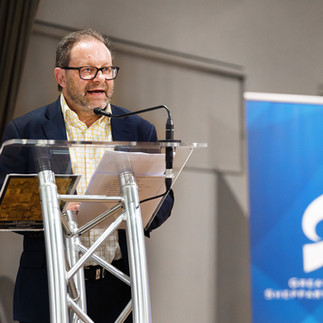

Linda Nieuwenhuizen
24 July 2025
Shepparton has long been home to leaders and innovators whose careers and businesses resonate far beyond our region—and this was on full display at our latest member event on 22 July.
The evening’s panels featured homegrown experts at the forefront of industries as diverse as jewellery, agriculture, water management, transport, and supply chain logistics, alongside Port of Melbourne, Global Victoria and ITC. Together the sessions underscored Shepparton’s regional and global importance.
Greater Shepparton Goes Global – our global reach and impact
Shepparton has long been home to leaders and innovators whose careers and businesses resonate far beyond our region—and this was on full display at our latest member event on 22 July.
The evening’s panels featured homegrown experts at the forefront of industries as diverse as jewellery, agriculture, water management, transport, and supply chain logistics, alongside Port of Melbourne, Global Victoria and ITC. Together the sessions underscored Shepparton’s regional and global importance.
Scroll to the bottom of the article to view and download our images from our event photo gallery.
Greater Shepparton - a launchpad for global careers
Dr Mark Morley reflected on his journey from growing up on a dairy farm in Numurkah and not excelling at school, to beginning a business degree at La Trobe Shepparton before transferring to complete his degree in advanced Arabic and economics.
“I have enjoyed incredible opportunities as a trade ambassador in the middle east working for the Australian Government and working with Australian businesses and exporters. And it’s this experience I am now using to grow Provincial Foods here in Shepparton,” said Mark.
Stephen Schneider of Stephens Jewellers had similar reflections.
“My parents owned the Permewans store, and my afterschool job was installing TV antennas when home electronics were taking off. This is where I learned to listen and communicate with customers – and this skill set has been the key to everything that followed,” said Stephen.
He later pursued a degree in electronics and held senior roles at Hitachi Consumer Electronics Australia, including National Product Manager and Strategic Planning Manager, leading service and supply teams and regularly involved in Hitachi’s multinational strategy development and training. Drawing on these skills, Stephen made a successful transition into the jewellery industry, acquiring and growing Stephens Jewellers.
Today, Stephen is actively engaged in national leadership within the Australian jewellery sector, serving as a Director and Board Chair of the Showcase Jewellers Group, a network representing 250 regional jewellers across Australia. He is also involved with the Jewellers Association of Australia (JAA), working on procurement and trade negotiations with major international jewellery and precious metals hubs including India, Thailand, Hong Kong, and Dubai.
Peter Moller shared insights into his career journey, beginning in Perth where he started as an agronomist after completing a Bachelor of Applied Science (Agriculture) in Sydney, with a focus on water and irrigation management. Further training in business management and several successful water management startups in America and Australia, saw Peter relocate to Shepparton as the Business Development Manager at Rubicon Water - another of Shepparton’s many local success stories.
While based in Shepparton, Peter was awarded a Food Source Victoria Scholarship with the Victorian Government, which enabled him to study Innovation and Entrepreneurship at Stanford University, California.
“This prepared me to understand how to take Rubicon solutions, manufactured in Shepparton, global”, said Peter.
As a result, his role has taken him to California and beyond, applying advanced irrigation technology to improve water efficiency and sustainable farming practices worldwide.
Peter said his career has reinforced the importance of working with customers to find a solution; not create a product and then try to find a market for it.
Paul Stagg shared his extensive expertise in trade and market development, particularly in China and Asia, highlighting his ongoing efforts to drive export growth for regional producers. Reflecting on his experience Paul emphasised the importance of building strong commercial relationships.
“Every market is different, but the core requirement is to build relationships, understand consumer needs and support industry to connect with buyers and suppliers remains.”
C4GS new director Andrew Yeoland moderated the second panel and drew on his experience working with O-I a global glass packaging manufacturer in Vietnam, China and Europe and is now back in Australia working in the waste, recycling, and logistics sector with FOOTT.
Tina Parfitt described a career journey that began with a Commerce degree that led to roles across the freight supply chain working with major companies such as Linfox and Lactalis, across intermodal commercial and operational leadership roles.
“I was able to take my experience and skills in road and rail freight into a new role with the Port,” said Tina.
Nick Gysberts reflected on a career that began with developing industrial warehousing, to his current role as Commercial Manager ITC Melbourne that is developing the Melbourne Intermodal Terminal at Somerton.
Nick shared how experiences like implementing automation systems and driving multimodal freight strategies continue to redefine career opportunities in the sector.
“Not so long-ago industrial land development was the ugly duckling of property development, but the massive growth and demand for efficient warehousing and logistics had changed this,” said Nick.
Turbulent times
The diverse panel provided multiple insights into current global trade and geo-political events.
“Australia produces at least 3 times the food we need to feed our population. We don’t live with the threat of food insecurity. Many of our trade partners have natural resources and wealth but not the soil, water, skills and logistics that are needed for food security. For them, food security goes hand in hand with national security,” said Mark Morley.
“We should be proud of our contribution to global food and national security – and we should think very carefully before adopting policies that limit our food production, processing, and export capability, “said Mark.
Stephen reflected on the historical role of gold during turbulent economic and political times.
“Maybe a decade ago nation states held about 10 to 15% of the world gold reserves, today this has increased above 25%, and individuals are also increasing their ownership of gold,” said Stephen.
“This means the price of gold for jewellery has increased significantly. A pair of earrings that would retail for $30, now costs more than $100,” said Stephen.
In contrast technology developed to grow diamonds for industrial use, is now producing diamonds that are cheaper, bigger and of equal and even better quality than mined diamonds.
“We’ve gone from 500 million years to produce a mined diamond, to 500 hours for a grown diamond and were heading towards 50 hours,” said Stephen.
Stephen said the change in technology has also coincided with the centre for the precious gems industry and trade shifting from Amsterdam to Mumbai.
Paul said China will continue to be a key market for Australian producers, but diversification was key.
“Global Vic has reintroduced introduced regionally based trade development staff and they have a key part of our efforts to support business expand trade into more markets particularly across Asia." said Paul.
Investing in trust
The panel members were consistent in their messages around building trust with buyers and suppliers.
“We bring international customers to the Goulburn Valley to show them a modernised irrigation network in action. Seeing the finished product in action is key to us establishing a shared vision,” said Peter Moller.
Paul, Mark and Stephen also referenced the importance of trade delegations and encourage Greater Shepparton industry to participate in international trade shows.
“Recently we brought a trade delegation to Mildura and Shepparton so they can see first-hand how their fruit and product is produced, and we will be supporting industry to have a presence at global trade events like Fruit Logistica,” said Paul.
Logistics – meeting the growing challenge
The event’s second panel, Export Logistics, saw new C4GS board member Andrew Yeoland, CEO of Foott speak with Nick Gysberts from ITC Melbourne and Tina Parfitt from the Port of Melbourne.
Andrew began with some projections for Victoria’s freight activity.
“Activity is expected to double if not triple to 900 million tonnes by 2050, container freight through the Port of Melbourne is expected to increase from 3.4 million containers to 6.5 million containers by 2052 and for every one person that moves to Victoria, an extra four-square meters of warehousing space is required,” said Andrew.
The Port of Melbourne recently presented to the C4GS Finance and Agribusiness member forum and outlined the demand growth and infrastructure needs driving its 5-year review of its 30-year strategy.
“In the last 5 years we extended VICT’s berths to accommodate two 350 metre ships at a time – prior to that there wasn’t a need to accommodate two vessels over 300 metres in length. The industry is continually changing, and our infrastructure needs to match, which is why we’ve invested more than $810 million in port infrastructure since 2016 and a further $700 million expected by 2028,” said Tina.
Tina said the Westgate tunnel scheduled to open later this year would remove the current curfews and allow 24/7 access to the port and the intermodal centres operating alongside rail and road freight would help moderate congestion to and from the port.
Climate change and erratic weather events are also in the mix.
“The Port of Melbourne will remain a vital part of Australia’s logistics infrastructure because it is located in a bay. Port of Melbourne is inside a bay, so it is more protected from extreme weather events than the next busiest container port – Port Botany in Sydney,” said Tina.
Tina also highlighted the change in workforce and skills at the port.
“Our newest terminal is fully automated. The staff who unload and load the containers from the ships are located in a control room – and many are gamers who have brought their skills to this new role. “
Nick said the ITC site at Somerton had required 30,000 square metres of post-tensioned concrete.
“The goal is for freight to be picked up and dropped off at our site. Our 600-metre rail shuttle will run on a dedicated line moving containers from our site to port in an hour. Removing that last congested 20km from the current 200 km trip from Shepparton to the Port we estimate will allow road freight operators to do three trips a day instead of two,” said Nick.
When asked how the costs will compare to current freight rates, Nick said rates will improve as volumes grow.
“We know intermodals are working very successfully across Europe and the USA and NSW is well ahead of us. Given the projected growth in total freight activity, we need investments like Somerton to work alongside existing freight services,”
In thanking the panel participants, C4GS Board members Andy Mann urged attendees to take up the offer from the Port of Melbourne to join one of its Port tours.
“We know our region is a key contributor to the product coming in and going out of the Port – we encourage you to see it firsthand,” said Andy.
With the panel sessions completed the event changed gears with Wankernomics presenters James and Charles challenging workday norms from emails to vision and mission statements to values - and concluding with a glimpse of the future with AI driven values and marketing.
The very humorous and accurate insights lead to the establishment of Andy Mann’s new company Andustria complete with a suite of AI generated promotional collateral.
C4GS would like to thank all our presenters, Cam and Ang and team at the Woolshed and importantly our event supports ITS, Global Vic and Greater Shepparton City Council. In lieu of gifts, the Committee for Greater Shepparton has made a donation to the Greater Shepparton Foundation's Forever Fund on behalf of each panel participant.











































































































































